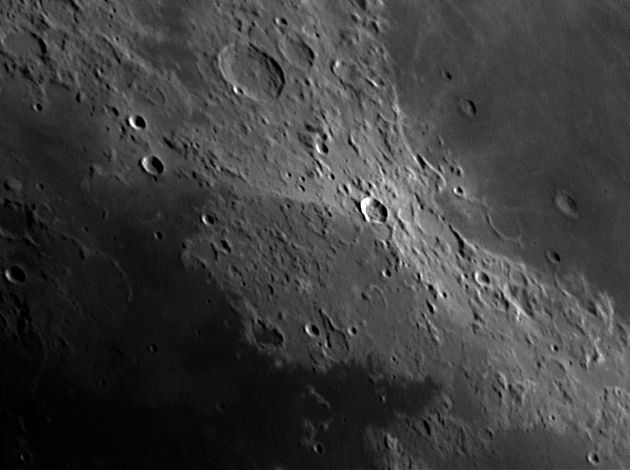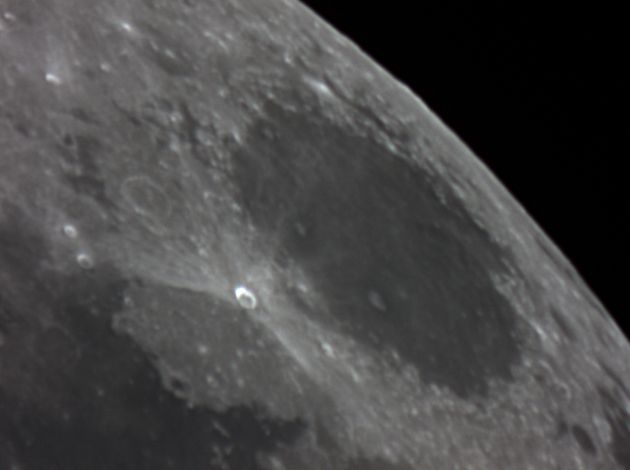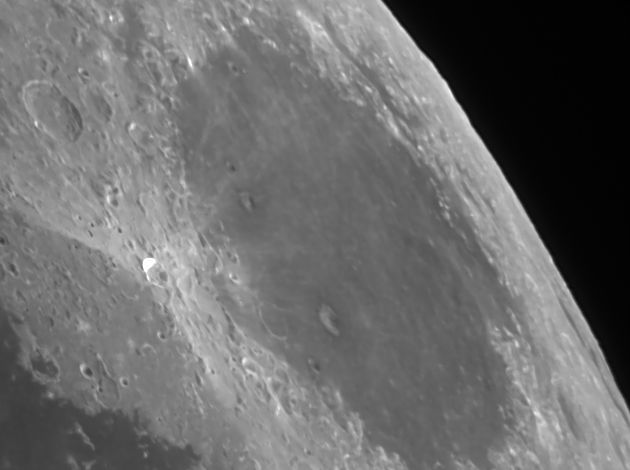

Proclus is a small crater (only 29 Km in diameter) but very interesting nevertheless. It is very young, certainly less than 1,000 million years and probably even younger. We can see this from the fact that its ejecta are still very light in colour. Over the eons, the lunar surface darkens by "weathering" - the continual bombardment by micro-meteors from space. The underlying rock is much lighter. Thus when a large meteor strikes the surface and creates a crater, it throws out the lighter-coloured underlying rock and spreads it all around over the darker pre-existing surface. Then slowly over time this darkens. The ejecta are not so obvious in this picture but can be seen more clearly in my picture of the eastern maria in which Proclus is the tiny white circle just west of Mare Crisium. The ejecta tell us something else as well. It can be seen (again more clearly in the other picture) that the ejecta are not evenly distributed around the crater. This pattern tells us that the projectile hit the Moon at a very shallow angle (probably no more than 15°) and came from the south-west. Such impacts throw most of the ejecta forward, but also produce strong rays bordering a shadow zone up-range. Move your mouse over the picture to see the names of the various craters.

The other interesting feature of this picture is Palus Somni. This looks like a dark patch of terrain that has been given the name The Marsh of Sleep but in fact it is the same hue as most highland terrain (compare with Macrobius and the region to the east). It is simply an area outlined by the two bright, fresh rays from Proclus, and missed by the ejecta from this very-oblique impact.
The scale markers are approximately 100 Km north and east.
The picture was taken with a ToUcam attached to my LX200 on 2nd June 2006 at 21:18 UT, when the Moon was 6.4 days old.
Date and Time: 2nd June 2006 21:18 UT
Phase: 101.6°
Colongitude: 346.8°
Libration Latitude -2° 39', Longitude 1° 22'
Camera: ToUcam 740K
Telescope: LX200 at prime focus with IR-pass filter
Capture: K3CCDTools. Low gamma, 1/33", 2% gain, 604 frames
Processing: Registax. 142 frames stacked. Wavelets 1 = 10, 2 = 5, histogram 0-150

This picture was taken at a time when the Sun was high in the lunar sky and so appears rather flat. It does make identification of features more difficult but I have concentrated on the bright craters that show up well. The rays from Proclus are clearer than they are in the picture above and it can clearly be seen that the area of Palus Somni is clear of rays whereas in the opposite direction they are numerous, confirming the oblique nature and the direction of the impact that created it.
The scale markers are approximately 100 Km north and west and apply at Proclus.
The picture was taken with a DFK camera attached to my ETX125 on 22nd May 2021 at 21:18 UT, when the Moon was 10.7 days old.
Date and Time: 22nd May 2021 21:18 UT
Phase: 56.4°
Colongitude: 45.6°
Libration Latitude -5° 7', Longitude -5° 38'
Camera: DFK 21AF04
Telescope: ETX125 at prime focus
Capture: ICCapture. 1/308", 795 gain, 1733 frames
Processing: Registax. 535 frames stacked. Wavelets 1-2 = 10

Almost the same area as above taken almost a year later, but this time with the longer focus LX200 so that the image covers a smaller area. It was taken slightly earlier in the lunar day (Day 7.3) so the shadows are a little more prominent. I have included Lacus Risus Felis in the mouseover; this is an unofficial name given to this dark patch by Charles Wood in his book The Modern Moon and can be better seen in the second picture on this page. It is particularly prominent in pictures of this kind compared to more detailed pictures from spacecraft.
Note that my convention is to place the first letter of a name on the object it refers to, so Lyell is the large crater under the leading L and not the little one at the end of the word (which is Proclus A).
The scale markers are approximately 100 Km North and East and apply at Proclus.
Date and Time: 8th May 2022 20:46 UT
Phase: 91.6°
Colongitude: 4.2°
Libration Latitude -6° 10', Longitude -6° 1'
Camera: DMK 21AF04 with IR-pass filter
Telescope: LX200 at prime focus
Capture: ICCapture. 1/154", 701 gain, 3387 frames
Processing: Registax5. 3059 frames stacked. Wavelets 1-2 = 10, Gamma 1.3
Focus Magic width 2.
Home Back to NE Quadrant